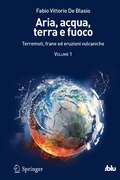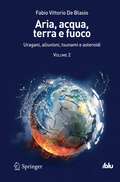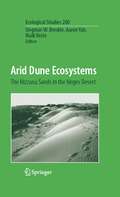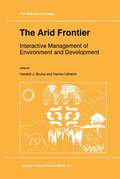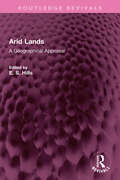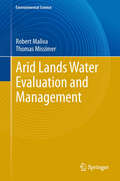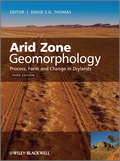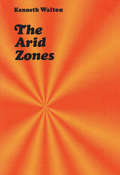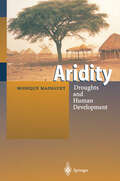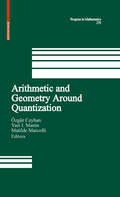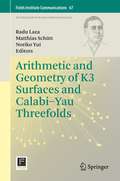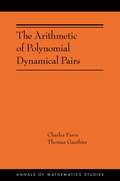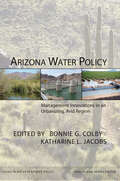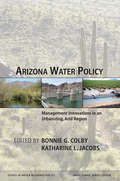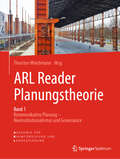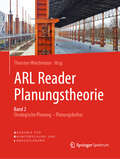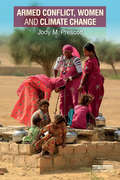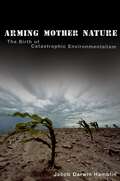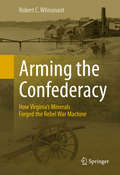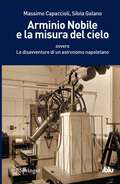- Table View
- List View
Aria, acqua, terra e fuoco - Volume I: Terremoti, frane ed eruzioni vulcaniche (I blu)
by Fabio Vittorio De BlasioLe catastrofi sono classificate in base agli elementi della tradizione filosofica ellenica e la loro ragione fisica è alla base dell'intera trattazione. Il libro è diviso in due volumi, indipendenti ma correlati allo stesso tempo. Nel primo, dopo una breve introduzione alle catastrofi naturali, si affrontano le catastrofi della terra e quelle del fuoco: terremoti, frane, eruzioni vulcaniche. Vengono fornite alcune informazioni sull'interno della Terra, necessarie per comprendere l’origine delle catastrofi. L’autore si cimenta in un vero e proprio esperimento letterario, combinando problematiche diverse all’interno della stessa opera. Così, per esempio, dopo uno studio sulle cause delle frane, si analizza la visione medioevale delle catastrofi, per poi ritornare agli argomenti principali del libro, il tutto arricchito da numerosi esempi e racconti che rendono la trattazione vivace e coinvolgente.
Aria, acqua, terra e fuoco - Volume II: Uragani, alluvioni, tsunami e asteroidi (I blu)
by Fabio Vittorio De BlasioQuesto secondo volume prosegue la breve trattazione sulle catastrofi naturali. È la volta delle catastrofi dell’acqua e dell’aria, spesso sui giornali quando un uragano o un’inondazione colpiscono il nostro pianeta. E anche delle minacce cosmiche, rare ma in grado di annientare la nostra civiltà.Vedremo quegli straordinari eventi di cui conosciamo l’esistenza dallo studio degli strati geologici e dei fossili, ma la cui causa è ancora avvolta nel mistero. Si tratta delle estinzioni di massa, episodi in cui la biosfera è cambiata in maniera improvvisa e drammatica a causa di una catastrofe globale.Tra un aneddoto e una digressione sulle basi scientifiche dei fenomeni e passando attraverso qualche caso di studio, si incuriosisce il lettore su un tema importante e coinvolgente.
Arid Dune Ecosystems: The Nizzana Sands in the Negev Desert (Ecological Studies #200)
by Siegmar-W. Breckle Aaron Yair Maik VesteSand dune dynamics play a key role in many arid deserts. This volume provides a thorough analysis of a specific sand dune ecosystem, the Nizzana site in the Middle East’s Negev Desert. Describing its climate, as well as its geophysical/geochemical soil properties and ecology, this brilliant work draws out the relationships between the site’s ecological and geomorphological processes, based on long-term monitoring, in situ experiments and satellite imagery.
The Arid Frontier: Interactive Management of Environment and Development (GeoJournal Library #41)
by Hendrik J. Bruins Harvey LithwickThe arid frontier has been a challenge for humanity from time immemorial. Drylands cover more than one-third of the global land surface, distributed over Africa, Asia, Australia, America and Southern Europe. Disasters may develop as a result of complex interactions between drought, desertification and society. Therefore, proactive planning and interactive management, including disaster-coping strategies, are essential in dealing with arid-frontier development. This book presents a conceptual framework with case studies in dryland development and management. The option of a rational and ethical discourse for development that is beneficial for both the environment and society is emphasized, avoiding extreme environmentalism and human destructionism, combating both desertification and human livelihood insecurity. Such development has to be based on appropriate ethics, legislation, policy, proactive planning and interactive management. Excellent scholars address these issues, focusing on the principal interactions between people and dryland environments in terms of drought, food, land, water, renewable energy and housing. Audience: This volume will be of great value to all those interested in Dryland Development and Management: professionals and policy-makers in governmental, international and non-governmental organizations (NGOs), as well as researchers, lecturers and students in Geography, Environmental Management, Regional Studies, Development Anthropology, Hazard and Disaster Management, Agriculture and Pastoralism, Land and Water Use, African Studies, and Renewable Energy Resources.
Arid Lands: A Geographical Appriasal (Routledge Revivals)
by E. S. HillsIn 1951 UNESCO launched an Arid Zone Programme with the object of promoting research into arid regions from every relevant scientific point of view. This book, originally published in 1966, represents the range of research undertaken and gives a general conspectus of arid zone geography. 17 authors from 8 countries contributed and the book deals comprehensively with all the main areas, with specific examples used to illustrate arguments. There are chapters on meteorology, geology, geomorphology, botany and zoology and almost 50% of the book is devoted to man’s activities: irrigation and agriculture; industry; animal breeding and human survival in the desert
Arid Lands: A Geographical Appriasal (Routledge Revivals)
In 1951 UNESCO launched an Arid Zone Programme with the object of promoting research into arid regions from every relevant scientific point of view. This book, originally published in 1966, represents the range of research undertaken and gives a general conspectus of arid zone geography. 17 authors from 8 countries contributed and the book deals comprehensively with all the main areas, with specific examples used to illustrate arguments. There are chapters on meteorology, geology, geomorphology, botany and zoology and almost 50% of the book is devoted to man’s activities: irrigation and agriculture; industry; animal breeding and human survival in the desert
Arid Lands Water Evaluation and Management (Environmental Science and Engineering)
by Robert Maliva Thomas MissimerA large part of the global population lives in arid lands which have low rainfall and often lack the water required for sustainable population and economic growth. This book presents a comprehensive description of the hydrogeology and hydrologic processes at work in arid lands. It describes the techniques that can be used to assess and manage the water resources of these areas with an emphasis on groundwater resources, including recent advances in hydrologic evaluation and the differences between how aquifer systems behave in arid lands versus more humid areas. Water management techniques are described and summarized to show how a more comprehensive approach to water management is required in these areas, including the need to be aware of cultural sensitivities and conditions unique to many arid regions. The integration of existing resources with the addition of new water sources, such as desalination of brackish water and seawater, along with reusing treated wastewater, will be required to meet future water supply needs. Also, changing climatic conditions will force water management systems to be more robust so that future water supply demands can be met as droughts become more intense and rainfall events become more intense. A range of water management techniques are described and discussed in order to illustrate the methods for integrating these measures within the context of arid lands conditions.
Arid Zone Geomorphology: Process, Form and Change in Drylands
by David S. G. ThomasThe new edition of Arid Zone Geomorphology aims to encapsulate the advances that have been made in recent years in the investigation and explanation of landforms and geomorphological processes in drylands. Building on the success of the previous two editions, the Third Edition has been completely revised and updated to reflect the latest developments in the field. Whilst this latest edition will remain a comprehensive reference to the subject, the book has been restructured to include regional case studies throughout to enhance student understanding and is clearly defined into five distinct sections; Firstly, the book introduces the reader to Large Scale Controls and Variability in Drylands and then moves on to consider Surface Processes and Characteristics; The Work of Water, The Work of the Wind. The book concludes with a section on Living with Dryland Geomorphology that includes a chapter on geomorphological hazards and the human impact on these environments. Once again, recognised world experts in the field have been invited to contribute chapters in order to present a comprehensive and up-to-date overview of current knowledge about the processes shaping the landscape of deserts and arid regions. In order to broaden the appeal of the Third Edition, the book has been reduced in extent by 100 pages and the Regional chapters have been omitted in favour of the inclusion of key regional case studies throughout the book. The Editor is also considering the inclusion of a supplementary website that could include further images, problems and case studies.
Arid Zone Geomorphology: Process, Form and Change in Drylands
by David S. G. ThomasThe new edition of Arid Zone Geomorphology aims to encapsulate the advances that have been made in recent years in the investigation and explanation of landforms and geomorphological processes in drylands. Building on the success of the previous two editions, the Third Edition has been completely revised and updated to reflect the latest developments in the field. Whilst this latest edition will remain a comprehensive reference to the subject, the book has been restructured to include regional case studies throughout to enhance student understanding and is clearly defined into five distinct sections; Firstly, the book introduces the reader to Large Scale Controls and Variability in Drylands and then moves on to consider Surface Processes and Characteristics; The Work of Water, The Work of the Wind. The book concludes with a section on Living with Dryland Geomorphology that includes a chapter on geomorphological hazards and the human impact on these environments. Once again, recognised world experts in the field have been invited to contribute chapters in order to present a comprehensive and up-to-date overview of current knowledge about the processes shaping the landscape of deserts and arid regions. In order to broaden the appeal of the Third Edition, the book has been reduced in extent by 100 pages and the Regional chapters have been omitted in favour of the inclusion of key regional case studies throughout the book. The Editor is also considering the inclusion of a supplementary website that could include further images, problems and case studies.
The Arid Zones
by Hilton KramerThe hot and temperate deserts and their marginal steppe lands comprise one-third of the land surface of the world and are an increasingly critical area for the economic wellbeing of world populations. The remarkable mechanisms of floral, faunal, and human adaptation to the distinct and difficult environment of these arid zones, as well as the potential of modern technology for facilitating adaptation, are described and explained by Walton in the light of our most recent knowledge of the phenomena and processes involved.Beginning with a clarification of the definitions of arid and semi-arid regions and with the delineation of techniques for measuring the degree of aridity in these areas, the author shows that there is wide variation among the arid zones in landscape and climate and that there are numerous local and microclimates within any single arid region. The life cycles of the plants and animals of the arid zones are described and the water resources, including problems of salinity, mineral contamination, and the construction of reservoirs, are examined. Extensive treatment is given to potential agricultural adaptations and to pastoralism as the most widespread response to dry land. A final chapter summarizes attempts at adaptation to prevailing drought and discusses the kinds of future development that the author deems most likely in arid zones.Throughout the book emphasis is placed on specific, detailed analysis, with adequate tables and formulas for in-depth understanding of particular aspects of aridity. Examples from both Old and New Worlds are used to demonstrate the spheres in which progress is being made and to show the mistakes in past and present land use in arid areas. An essential supplement for courses in physical geography, the book will be useful in many area studies and in studies of economic development.
The Arid Zones
by Hilton KramerThe hot and temperate deserts and their marginal steppe lands comprise one-third of the land surface of the world and are an increasingly critical area for the economic wellbeing of world populations. The remarkable mechanisms of floral, faunal, and human adaptation to the distinct and difficult environment of these arid zones, as well as the potential of modern technology for facilitating adaptation, are described and explained by Walton in the light of our most recent knowledge of the phenomena and processes involved.Beginning with a clarification of the definitions of arid and semi-arid regions and with the delineation of techniques for measuring the degree of aridity in these areas, the author shows that there is wide variation among the arid zones in landscape and climate and that there are numerous local and microclimates within any single arid region. The life cycles of the plants and animals of the arid zones are described and the water resources, including problems of salinity, mineral contamination, and the construction of reservoirs, are examined. Extensive treatment is given to potential agricultural adaptations and to pastoralism as the most widespread response to dry land. A final chapter summarizes attempts at adaptation to prevailing drought and discusses the kinds of future development that the author deems most likely in arid zones.Throughout the book emphasis is placed on specific, detailed analysis, with adequate tables and formulas for in-depth understanding of particular aspects of aridity. Examples from both Old and New Worlds are used to demonstrate the spheres in which progress is being made and to show the mistakes in past and present land use in arid areas. An essential supplement for courses in physical geography, the book will be useful in many area studies and in studies of economic development.
Aridity: Droughts and Human Development
by Monique MainguetAt the intersection of environmental science and human biology, this book deals with dry ecosystems, the societies so affected, and the inventiveness of those living under such conditions. It also tries to answer the question of whether long-lasting development is possible in dry environments.
Arithmetic and Geometry Around Quantization (Progress in Mathematics)
by Özgür Ceyhan Yu. I. Manin Matilde MarcolliThis volume comprises both research and survey articles originating from the conference on Arithmetic and Geometry around Quantization held in Istanbul in 2006. A wide range of topics related to quantization are covered, thus aiming to give a glimpse of a broad subject in very different perspectives.
Arithmetic and Geometry of K3 Surfaces and Calabi–Yau Threefolds (Fields Institute Communications #67)
by Radu Laza, Matthias Schütt and Noriko YuiIn recent years, research in K3 surfaces and Calabi–Yau varieties has seen spectacular progress from both arithmetic and geometric points of view, which in turn continues to have a huge influence and impact in theoretical physics—in particular, in string theory. The workshop on Arithmetic and Geometry of K3 surfaces and Calabi–Yau threefolds, held at the Fields Institute (August 16-25, 2011), aimed to give a state-of-the-art survey of these new developments. This proceedings volume includes a representative sampling of the broad range of topics covered by the workshop. While the subjects range from arithmetic geometry through algebraic geometry and differential geometry to mathematical physics, the papers are naturally related by the common theme of Calabi–Yau varieties. With the big variety of branches of mathematics and mathematical physics touched upon, this area reveals many deep connections between subjects previously considered unrelated. Unlike most other conferences, the 2011 Calabi–Yau workshop started with 3 days of introductory lectures. A selection of 4 of these lectures is included in this volume. These lectures can be used as a starting point for the graduate students and other junior researchers, or as a guide to the subject.
The Arithmetic of Polynomial Dynamical Pairs: (AMS-214) (Annals of Mathematics Studies #401)
by Charles Favre Thomas GauthierNew mathematical research in arithmetic dynamicsIn The Arithmetic of Polynomial Dynamical Pairs, Charles Favre and Thomas Gauthier present new mathematical research in the field of arithmetic dynamics. Specifically, the authors study one-dimensional algebraic families of pairs given by a polynomial with a marked point. Combining tools from arithmetic geometry and holomorphic dynamics, they prove an “unlikely intersection” statement for such pairs, thereby demonstrating strong rigidity features for them. They further describe one-dimensional families in the moduli space of polynomials containing infinitely many postcritically finite parameters, proving the dynamical André-Oort conjecture for curves in this context, originally stated by Baker and DeMarco.This is a reader-friendly invitation to a new and exciting research area that brings together sophisticated tools from many branches of mathematics.
Arizona Water Policy: Management Innovations in an Urbanizing, Arid Region (Issues in Water Resource Policy)
by Bonnie G. ColbyThe central challenge for Arizona and many other arid regions in the world is keeping a sustainable water supply in the face of rapid population growth and other competing demands. This book highlights new approaches that Arizona has pioneered for managing its water needs. The state has burgeoning urban areas, large agricultural regions, water dependent habitats for endangered fish and wildlife, and a growing demand for water-based recreation. A multi-year drought and climate-related variability in water supply complicate the intense competition for water. Written by well-known Arizona water experts, the essays in this book address these issues from academic, professional, and policy perspectives that include economics, climatology, law, and engineering. Among the innovations explored in the book is Arizona‘s Groundwater Management Act. Arizona is not alone in its challenges. As one of the seven states in the Colorado River Basin that depend heavily on the river, Arizona must cooperate, and sometimes compete, with other state, tribal, and federal governments. One institution that furthers regional cooperation is the water bank, which encourages groundwater recharge of surplus surface water during wet years so that the water remains available during dry years. The Groundwater Management Act imposes conservation requirements and establishes planning and investment programs in renewable water supplies. The essays in Arizona Water Policy are accessible to a broad policy-oriented and nonacademic readership. The book explores Arizona‘s water management and extracts lessons that are important for arid and semi-arid areas worldwide.
Arizona Water Policy: Management Innovations in an Urbanizing, Arid Region (Issues in Water Resource Policy)
by Bonnie G. Colby Katharine L. JacobsThe central challenge for Arizona and many other arid regions in the world is keeping a sustainable water supply in the face of rapid population growth and other competing demands. This book highlights new approaches that Arizona has pioneered for managing its water needs. The state has burgeoning urban areas, large agricultural regions, water dependent habitats for endangered fish and wildlife, and a growing demand for water-based recreation. A multi-year drought and climate-related variability in water supply complicate the intense competition for water. Written by well-known Arizona water experts, the essays in this book address these issues from academic, professional, and policy perspectives that include economics, climatology, law, and engineering. Among the innovations explored in the book is Arizona‘s Groundwater Management Act. Arizona is not alone in its challenges. As one of the seven states in the Colorado River Basin that depend heavily on the river, Arizona must cooperate, and sometimes compete, with other state, tribal, and federal governments. One institution that furthers regional cooperation is the water bank, which encourages groundwater recharge of surplus surface water during wet years so that the water remains available during dry years. The Groundwater Management Act imposes conservation requirements and establishes planning and investment programs in renewable water supplies. The essays in Arizona Water Policy are accessible to a broad policy-oriented and nonacademic readership. The book explores Arizona‘s water management and extracts lessons that are important for arid and semi-arid areas worldwide.
ARL Reader Planungstheorie Band 1: Kommunikative Planung - Neoinstitutionalismus und Governance
by Thorsten WiechmannBand 1 des ARL Readers Planungstheorie behandelt zwei der einflussreichsten planungstheoretischen Metaerzählungen des späten 20. Jahrhunderts: „Kommunikative Planung“ sowie „Neo-Institutionalismus und Governance“. Mit ihnen verbindet sich die erfolgreiche Überwindung einer technokratisch-rationalistischen Vorstellung von Planung. Kommunikation, Macht und Konflikt werden zu zentralen Kategorien der Auseinandersetzung mit der Planungsrealität.Der ARL Reader Planungstheorie leistet eine umfassende und doch pointierte Bestandsaufnahme des Diskussionsstandes. Als Sammelwerk präsentiert er Debatten bestimmende Originaltexte bekannter Autoren. Diese werden durch namhafte Planungswissenschaftler eingeordnet und kritisch diskutiert. Damit bietet der Band einen so bisher nie da gewesenen Überblick über die Grundlagen der aktuellen planungstheoretischen Debatten für Studierende der Raum- und Planungswissenschaften sowie fachlich interessierte Wissenschaftler und Praktiker.
ARL Reader Planungstheorie Band 2: Strategische Planung - Planungskultur
by Thorsten WiechmannBand 2 des ARL Readers Planungstheorie beleuchtet neuere planungstheoretische Diskursstränge des frühen 21. Jahrhunderts: „Strategische Planung“ und „Planungskultur“. Während der organisationstheoretisch untersetzte ‚Turn to Strategy’ als eine Antwort auf die Defizite inkrementeller Planung durch Projekte zu verstehen ist, zielen Ansätze, die Planen als kulturelle Praxis begreifen, auf ein tieferes Verständnis lokaler und regionaler Praktiken.Der ARL Reader Planungstheorie leistet eine umfassende und doch pointierte Bestandsaufnahme des Diskussionsstandes. Als Sammelwerk präsentiert er Debatten bestimmende Originaltexte bekannter Autoren. Diese werden durch namhafte Planungswissenschaftler eingeordnet und kritisch diskutiert. Damit bietet der Band einen so bisher nie da gewesenen Überblick über die Grundlagen der aktuellen planungstheoretischen Debatten für Studierende der Raum- und Planungswissenschaften sowie fachlich interessierte Wissenschaftler und Praktiker.
Armed Conflict, Women and Climate Change
by Jody M. PrescottThe gender-differentiated and more severe impacts of armed conflict upon women and girls are well recognised by the international community, as demonstrated by UN Security Council Resolution (UNSCR) 1325 on Women, Peace and Security and subsequent resolutions. Similarly, the development community has identified gender-differentiated impacts upon women and girls as a result of the effects of climate change. Current research and analysis has reached no consensus as to any causal relationship between climate change and armed conflict, but certain studies suggest an indirect linkage between climate change effects such as food insecurity and armed conflict. Little research has been conducted on the possible compounding effects that armed conflict and climate change might have on at-risk population groups such as women and girls. Armed Conflict, Women and Climate Change explores the intersection of these three areas and allows the reader to better understand how military organisations across the world need to be sensitive to these relationships to be most effective in civilian-centric operations in situations of humanitarian relief, peacekeeping and even armed conflict. This book examines strategy and military doctrine from NATO, the UK, US and Australia, and explores key issues such as displacement, food and energy insecurity, and male out-migration as well as current efforts to incorporate gender considerations in military activities and operations. This innovative book will be of great interest to students and scholars of international relations, international development, international security, sustainability, gender studies and law.
Armed Conflict, Women and Climate Change
by Jody M. PrescottThe gender-differentiated and more severe impacts of armed conflict upon women and girls are well recognised by the international community, as demonstrated by UN Security Council Resolution (UNSCR) 1325 on Women, Peace and Security and subsequent resolutions. Similarly, the development community has identified gender-differentiated impacts upon women and girls as a result of the effects of climate change. Current research and analysis has reached no consensus as to any causal relationship between climate change and armed conflict, but certain studies suggest an indirect linkage between climate change effects such as food insecurity and armed conflict. Little research has been conducted on the possible compounding effects that armed conflict and climate change might have on at-risk population groups such as women and girls. Armed Conflict, Women and Climate Change explores the intersection of these three areas and allows the reader to better understand how military organisations across the world need to be sensitive to these relationships to be most effective in civilian-centric operations in situations of humanitarian relief, peacekeeping and even armed conflict. This book examines strategy and military doctrine from NATO, the UK, US and Australia, and explores key issues such as displacement, food and energy insecurity, and male out-migration as well as current efforts to incorporate gender considerations in military activities and operations. This innovative book will be of great interest to students and scholars of international relations, international development, international security, sustainability, gender studies and law.
Arming Mother Nature: The Birth of Catastrophic Environmentalism
by Jacob Darwin HamblinWhen most Americans think of environmentalism, they think of the political left, of vegans dressed in organic-hemp fabric, lofting protest signs. In reality, writes Jacob Darwin Hamblin, the movement--and its dire predictions--owe more to the Pentagon than the counterculture. In Arming Mother Nature, Hamblin argues that military planning for World War III essentially created "catastrophic environmentalism": the idea that human activity might cause global natural disasters. This awareness, Hamblin shows, emerged out of dark ambitions, as governments poured funds into environmental science after World War II, searching for ways to harness natural processes--to kill millions of people. Proposals included the use of nuclear weapons to create artificial tsunamis or melt the ice caps to drown coastal cities; setting fire to vast expanses of vegetation; and changing local climates. Oxford botanists advised British generals on how to destroy enemy crops during the war in Malaya; American scientists attempted to alter the weather in Vietnam. This work raised questions that went beyond the goal of weaponizing nature. By the 1980s, the C.I.A. was studying the likely effects of global warming on Soviet harvests. "Perhaps one of the surprises of this book is not how little was known about environmental change, but rather how much," Hamblin writes. Driven initially by strategic imperatives, Cold War scientists learned to think globally and to grasp humanity's power to alter the environment. "We know how we can modify the ionosphere," nuclear physicist Edward Teller proudly stated. "We have already done it." Teller never repented. But many of the same individuals and institutions that helped the Pentagon later warned of global warming and other potential disasters. Brilliantly argued and deeply researched, Arming Mother Nature changes our understanding of the history of the Cold War and the birth of modern environmental science.
Arming Mother Nature: The Birth of Catastrophic Environmentalism
by Jacob Darwin HamblinWhen most Americans think of environmentalism, they think of the political left, of vegans dressed in organic-hemp fabric, lofting protest signs. In reality, writes Jacob Darwin Hamblin, the movement--and its dire predictions--owe more to the Pentagon than the counterculture. In Arming Mother Nature, Hamblin argues that military planning for World War III essentially created "catastrophic environmentalism": the idea that human activity might cause global natural disasters. This awareness, Hamblin shows, emerged out of dark ambitions, as governments poured funds into environmental science after World War II, searching for ways to harness natural processes--to kill millions of people. Proposals included the use of nuclear weapons to create artificial tsunamis or melt the ice caps to drown coastal cities; setting fire to vast expanses of vegetation; and changing local climates. Oxford botanists advised British generals on how to destroy enemy crops during the war in Malaya; American scientists attempted to alter the weather in Vietnam. This work raised questions that went beyond the goal of weaponizing nature. By the 1980s, the C.I.A. was studying the likely effects of global warming on Soviet harvests. "Perhaps one of the surprises of this book is not how little was known about environmental change, but rather how much," Hamblin writes. Driven initially by strategic imperatives, Cold War scientists learned to think globally and to grasp humanity's power to alter the environment. "We know how we can modify the ionosphere," nuclear physicist Edward Teller proudly stated. "We have already done it." Teller never repented. But many of the same individuals and institutions that helped the Pentagon later warned of global warming and other potential disasters. Brilliantly argued and deeply researched, Arming Mother Nature changes our understanding of the history of the Cold War and the birth of modern environmental science.
Arming the Confederacy: How Virginia’s Minerals Forged the Rebel War Machine
by Robert C. WhisonantThis is a fresh look at the American Civil War from the standpoint of the natural resources necessary to keep the armies in the field. This story of the links between minerals, topography, and the war in western Virginia now comes to light in a way that enhances our understanding of America’s greatest trial. Five mineral products – niter, lead, salt, iron, and coal – were absolutely essential to wage war in the 1860s. For the armies of the South, those resources were concentrated in the remote Appalachian highlands of southwestern Virginia. From the beginning of the war, the Union knew that the key to victory was the destruction or occupation of the mines, furnaces, and forges located there, as well as the railroad that moved the resources to where they were desperately needed. To achieve this, Federal forces repeatedly advanced into the treacherous mountainous terrain to fight some of the most savage battles of the War.
Arminio Nobile e la misura del cielo: ovvero Le disavventure di un astronomo napoletano (I blu)
by Massimo Capaccioli Silvia GalanoLa scienza è un’esaltante avventura che è costume raccontare attraverso le gesta dei grandi. Esiste però un’altra storia, altrettanto avvincente ma con poca voce, scritta dai tanti gregari e potenziali campioni cui la sorte, spesso nemmeno troppo cieca, ha negato la gloria. Questo libro parla di uno di loro e del suo piccolo mondo sulla collina di Capodimonte, a Napoli. È la parabola di Arminio Nobile – personaggio notevole eppure poco noto dell’astronomia italiana – svolta sulla scena della nascente astrofisica, in una stagione di grandi transizioni per il Mezzogiorno. Arminio, che era figlio di Giuseppina Guacci, figura di spicco della cultura pre-risorgimentale, e di un valente astronomo della Specola di Capodimonte, scelse di votarsi allo studio del cielo. Osservatore instancabile, appassionato e genialoide, aveva le carte in regola e le motivazioni per “sfondare”, ma la fortuna non gli arrise: più volte si beffò di lui, spingendolo su vicoli ciechi che la sua testardaggine gli impedì di abbandonare. Così, quando la grande occasione gli si parò davanti, la riconobbe ma non seppe coglierla appieno, morendo “disperato” come il pucciniano amante di Tosca.
